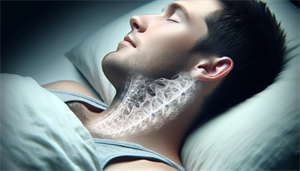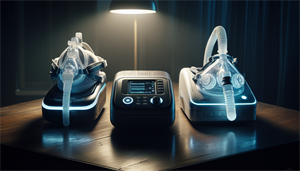Are you or your bed partner losing sleep due to incessant snoring? If so, a dental mouthpiece for snoring could be the solution you are searching for.
Key Takeaways
-
Snoring can significantly affect sleep quality and may indicate Obstructive Sleep Apnea (OSA), a condition characterized by repeated airway blockages leading to breathing interruptions during sleep.
-
Dental mouthpieces, such as Mandibular Advancement Devices (MADs) and Tongue Retaining Devices (TRDs), are commonly used to treat snoring by repositioning the tongue or lower jaw to maintain an open airway.
-
The selection of a dental mouthpiece for snoring should consider comfort, fit, customization, adjustability, cost, and insurance coverage; consulting with a dentist for a custom-fit solution can enhance effectiveness and comfort.
Understanding Snoring and Its Impact on Sleep
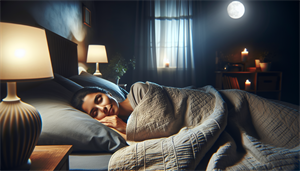
Snoring is more than a mere annoyance that can disrupt a peaceful night’s sleep for you and your bed partner. It’s a sign that your body is struggling to keep its airways open during sleep. When you sleep, the muscles in your mouth, throat, and tongue relax. This can cause these tissues to vibrate as you breathe, leading to the familiar, and often disruptive, snoring sound.
Your sleeping position could also play a part in contributing to this issue. Back sleepers, for instance, are more prone to snoring because this position allows gravity to pull the relaxed tongue and soft palate into the throat, obstructing the airway and causing you to snore.
Snoring can significantly impact sleep quality, leading to daytime drowsiness, irritability, and decreased productivity. More importantly, it may be a symptom of a more serious condition called obstructive sleep apnea (OSA), which can cause individuals to lose sleep.
Obstructive Sleep Apnea and Snoring: The Connection
A sleep disorder known as Obstructive Sleep Apnea (OSA) is characterized by:
-
Frequent pauses in breathing due to partial or complete blockage of the upper airway during sleep, which differentiates it from central sleep apnea
-
This blockage is often a result of the relaxation of throat muscles
-
It can cause the individual to snore loudly
One of the most frequent symptoms of OSA is snoring. An individual suffering from OSA might experience periods of heavy snoring followed by silence when breathing stops, then gasping or choking sounds when breathing resumes.
Many individuals manage OSA and the associated snoring by using oral devices such as anti-snoring mouthpieces and anti snoring device. These devices, like a custom mouth guard, are designed to:
-
Fit over the upper and lower teeth
-
Help maintain an open airway during sleep
-
Reduce the occurrence of snoring
-
Improve sleep quality.
Dental Mouthpieces for Snoring Relief: Types and Functions
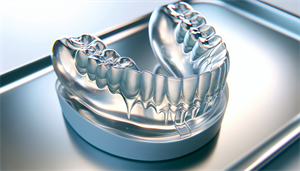
Despite the availability of several types of dental mouthpieces, Mandibular Advancement Devices (MADs) and Tongue Retaining Devices (TRDs) are the most commonly used to treat snoring.
The CustMbite Snoring System and the Thornton Adjustable Positioner (TAP) are examples of these devices that work by pulling the tongue forward or moving the lower jaw forward, respectively. This prevents the airway from getting obstructed, thereby reducing snoring episodes and helping users achieve a restful sleep.
Mandibular Advancement Devices (MADs)
Dental mouthpieces, known as Mandibular Advancement Devices (MADs) that work by moving the lower jaw forward, thereby moving the tongue forward and enlarging the retropalatal airway. This repositioning effectively decreases air resistance, increases the upper airway size, and can aid in reducing the occurrence of snoring.
A variety of MADs are available, such as adjustable MADs like MyTAP, and thermoplastic ‘boil and bite’ devices. These are tailored to accommodate different needs and preferences, offering options for those seeking relief from snoring.
Despite their proven effectiveness in managing snoring in different sleep positions, snoring mouthpieces do come with potential disadvantages. Users may experience:
-
Jaw pain
-
Stiffness
-
Drooling
-
Incompatibility with people who have braces or dentures
Additionally, a prescription is necessary for their use.
Tongue Retaining Devices (TRDs)
Snoring can be reduced using Tongue Retaining Devices (TRDs) by holding the tongue in place to prevent it from falling back and obstructing the airway. This ensures an unobstructed airway and reduces snoring episodes. TRDs offer benefits such as being lightweight, easy to use, and compatible with dentures or braces. However, they also have drawbacks, including a one-size-fits-all design that may not be suitable for everyone and the potential to restrict breathing by creating a seal around the mouth.
One should grip the tongue to insert a TRD, the tongue and place the device onto it. Removing the device involves simply pinching the rounded part to release it. Therefore, TRDs are not only effective in reducing snoring but also quite simple to use.
How to Choose the Right Dental Mouthpiece for You
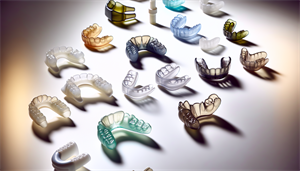
When choosing a dental mouthpiece, the decision should be grounded on personal needs and preferences. It’s crucial to consult a medical professional before purchasing a mouthpiece to ensure it is the most suitable for your specific needs.
Comfort, fit, customization, adjustability, and cost are important factors to consider when choosing a dental mouthpiece. Whether you opt for an MAD or a TRD, making the right choice can significantly improve your sleep quality and overall well-being.
Comfort and Fit
The role of comfort and fit is crucial in the success of a dental mouthpiece. An uncomfortable mouthpiece can result in irritation, pain, or difficulty sleeping, leading to non-compliance and discontinuation of use, which hinders effective snoring relief.
The direct influence on alleviating snoring comes from the fit of a dental mouthpiece. its effectiveness in alleviating snoring. A properly fitted mouthpiece ensures user comfort and minimizes discomfort or pain, while an ill-fitting one can lead to discomfort and may not effectively address snoring.
Various design elements influence the comfort of a dental mouthpiece. by various design elements. Trimming the palatal margin to the cervical area, ensuring a smooth finish, and providing a custom fit all play a role in enhancing retention and comfort. These factors are crucial for improving the user’s experience and the overall performance of the mouthpiece.
Nevertheless, challenges may arise in achieving the right comfort and fit, which can sometimes be challenging. Some of the typical challenges associated with the comfort and fit of dental mouthpieces include:
-
Pain, pressure, or soreness stemming from an inadequate fit
-
The potential for teeth shifting and jaw misalignment
-
Oral irritation
-
Heightened sensitivity
-
The risk of injuries from improperly fitted mouthguards
-
Challenges in fitting custom mouthguards for orthodontic patients
-
Issues impacting breathing, speaking, swallowing, chewing, and retention
Customization and Adjustability
Another set of factors that contribute to overall satisfaction are customization and adjustability. of factors that contribute to the overall satisfaction with a dental mouthpiece. A custom-made mouth guard offers a more tailored fit and enhanced comfort compared to store-bought options.
Custom dental mouthpieces are usually customized using a plastic-like mold that conforms to the specific shape of the patient’s mouth, or through a ‘boil and bite’ process where the device is heated and bitten down on for a custom fit. This ensures that the mouthpiece fits perfectly and comfortably in your mouth, thereby improving its effectiveness in reducing snoring.
Crucial in preventing discomfort and pain is the level of customization. in preventing discomfort and pain by promoting jaw relaxation, reducing muscle tension, and soreness. Moreover, tailored guards can address individual jaw structures, thus mitigating symptoms related to TMJ disorder.
Cost and Insurance Coverage
When choosing a dental mouthpiece, cost is a significant aspect to consider. a dental mouthpiece. The typical price range for over-the-counter mandibular advancement devices (MADs) and tongue retaining devices (TRDs) sold today is between $50 and $150 per piece.
On the other hand, the average costs of custom-fitted dental mouthpieces for snoring can range from $90 to $2500, depending on the type of mouthpiece and the level of customization needed. Some insurance plans may cover a portion of these costs, potentially lowering the patient’s out-of-pocket expenses.
There are many dental insurance plans and Medicare that cover oral devices for sleep apnea. This can be helpful for those seeking treatment for their condition. However, coverage can differ, so it’s important to check with your specific insurance provider.
The Role of Dentists in Snoring Relief

In snoring relief, dentists play an indispensable role, starting from the diagnosis to providing custom-made dental mouthpieces. They prescreen patients for sleep disorders, including teeth grinding, during initial consultations and routine dental examinations by examining patient history and looking for signs that may indicate the presence of sleep disorders.
An effective method for addressing snoring is oral appliance therapy, which can combat snoring. It entails utilizing a personalized appliance that is designed to fit over the teeth and delicately reposition the lower jaw to prevent airway obstruction by soft tissues.
These appliances are personalized by dentists by capturing an impression of the teeth using a soft material or a digital scanner, resulting in a tailored device that caters to the specific requirements of the patient. This ensures that the mouthpiece provides maximum comfort and optimal results.
To schedule a visit for oral appliance therapy, a patient can contact the dentist’s practice by phone or online to arrange an initial consultation.
Caring for Your Dental Mouthpiece
The longevity and optimal performance of your dental mouthpiece hinge on its proper care and maintenance. The best practices for cleaning dental mouthpieces include:
-
Deep cleaning with an OTC denture cleaner or a mixture of vinegar and hydrogen peroxide
-
Soaking the mouthpiece for an hour or overnight for thorough disinfection
-
Using toothpaste and a toothbrush for regular cleaning
Following these steps can prolong the lifespan of your dental mouthpiece and ensure optimal performance.
Regular toothpaste is suitable for cleaning dental mouthpieces. However, it is advisable to choose a nonabrasive toothpaste to prevent potential scratching of the mouthpiece, which could lead to increased susceptibility to bacterial growth and a reduced lifespan.
When not in use, it is recommended to store the dental mouthpiece in a clean case to safeguard it from damage and environmental contaminants like dust and debris.
Alternative Snoring Solutions
Despite the effectiveness of dental mouthpieces, for many, there are other options available for snoring relief. Positive air pressure (PAP) therapy is one such method that uses a machine to intake outside air, humidify it, pressurize it, and deliver it to the user through a connected hose and a face mask covering the mouth and/or nostrils. The three prevalent types of PAP therapy are CPAP, BiPAP, and APAP.
A doctor’s prescription is required for PAP therapy machines, humidifiers, and face masks. a doctor’s prescription in order to be obtained. This ensures that the equipment is used appropriately and safely..
Surgical interventions might be considered for those who don’t find relief with dental mouthpieces or PAP therapy. These include:
-
Uvulopalatopharyngoplasty, which involves the removal of excess throat tissue
-
Radiofrequency tissue ablation, aimed at reducing tissue bulk in the upper airway
-
Maxillomandibular advancement surgery, which involves repositioning the jaw to enlarge the upper airway
-
Hypoglossal nerve stimulation, a procedure that reprograms nerves controlling tongue movements to prevent airway blockage.
Summary
In conclusion, snoring can significantly impact sleep quality and may even be a symptom of a more serious condition such as obstructive sleep apnea. Dental mouthpieces, such as Mandibular Advancement Devices and Tongue Retaining Devices, can provide effective relief from snoring. When choosing a dental mouthpiece, factors such as comfort, fit, customization, adjustability, and cost should be considered. Dentists play a crucial role in snoring relief and can provide custom-made dental mouthpieces based on individual needs. Proper care and maintenance of the mouthpiece can ensure its longevity and effectiveness. Finally, other snoring solutions, such as PAP therapy and surgical interventions, can be considered for those who do not find relief with dental mouthpieces.
Frequently Asked Questions
Do dental mouthguards work for snoring?
Yes, dental mouthguards can work for snoring by pulling the lower jaw forward to keep the airway open, reducing snoring caused by the vibrations of soft tissue in the upper airway.
Can dentists make anti snoring mouthpieces?
Yes, dentists can make anti-snoring mouthpieces by assessing the patient's condition and prescribing a customized mouthguard that fits the patient's mouth and teeth, helping to hold the airway open during sleep.
What dental device is used to reduce snoring?
To reduce snoring, a mandibular advancement device can be used, which is a widely used dental appliance that forces the lower jaw down and forward slightly, resembling a sports mouth guard.
What causes snoring and how can it be treated?
Snoring is caused by an obstruction in the airflow through the mouth and nose and can be treated with an anti-snoring device like a dental mouthpiece. Try using this device to help reduce snoring.
What's the connection between snoring and Obstructive Sleep Apnea?
The connection between snoring and Obstructive Sleep Apnea is that snoring is a common symptom observed in individuals with Obstructive Sleep Apnea, indicating the partial or complete blockage of the upper airway during sleep.
